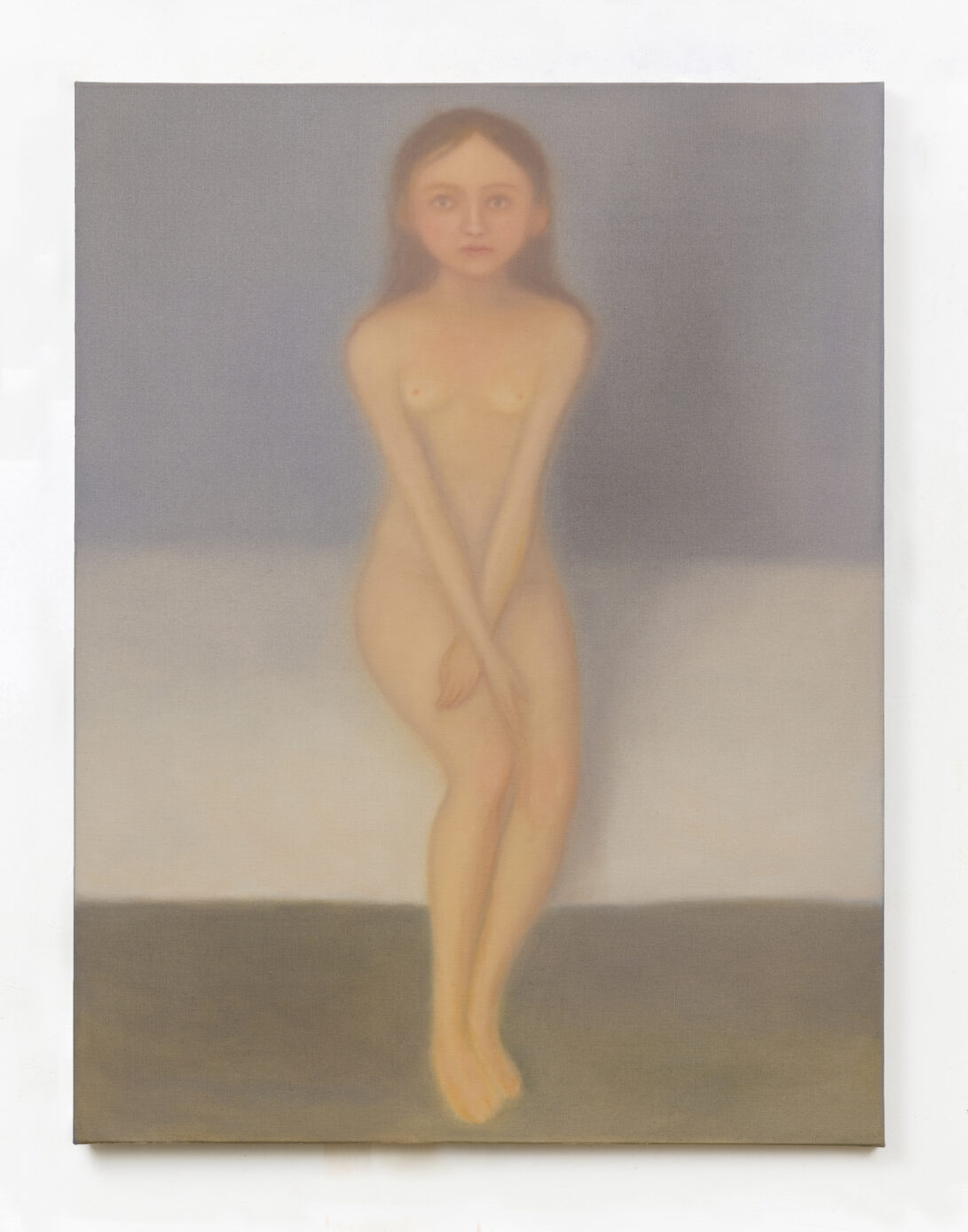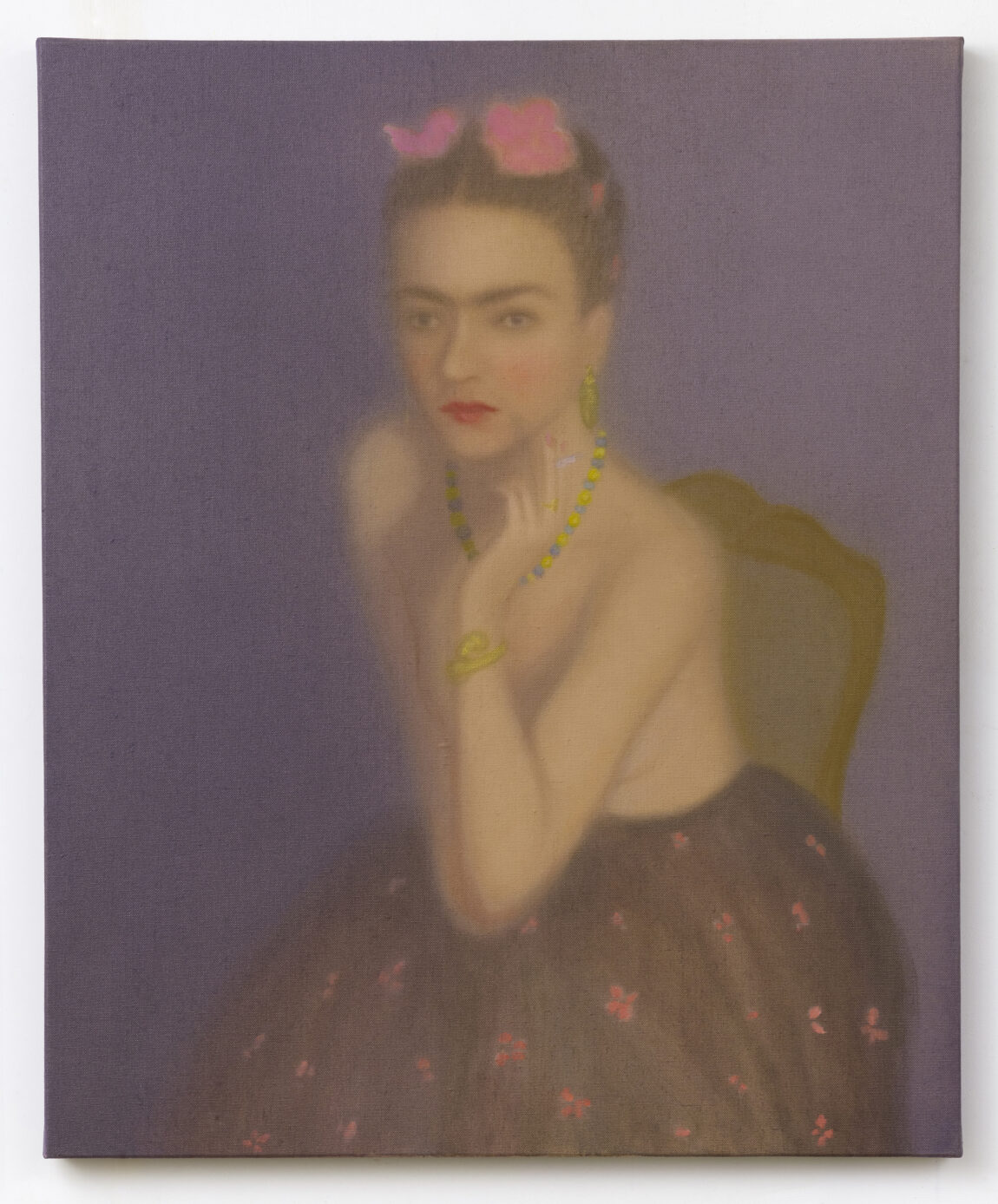The gauzy, auratic atmosphere of Chechu Álava’s paintings is often offset by the directness of her subject’s gaze. Amplified by her chosen palette of fleshy, pearlescent pinks and postmodern pastels, the effect is strangely erotic. It is a soft-focus affair – a coming together of “sex” and spirit that conjures the creamy, dreamy, transubstantiated flesh of saints, angels, and gods in the frescoes of cathedrals.
Born in 1973 in Asturias, Spain, Álava currently lives and works in Paris, France. She was awarded the Erasmus Scholarship to study at the Rietveld Academie in Amsterdam in 1995 and obtained her Bachelor of Fine Arts at the University of Salamanca in 1996. In 2020 Álava presented her first major museum exhibition, Rebeldes, at the Thyssen Museum in Madrid, Spain, which was accompanied by an artist’s monograph. She has a solo exhibition planned for BravinLee Programs in New York City in September 2021.
Some of Álava’s paintings, like her recent rendition of Edvard Munch’s Puberty, are reinterpretations of works by earlier (male) artists. These riffs signal a self-reflexive interest in the history of art – a remaking or re-scripting of the canon on her own terms. She began painting Confinement (after Munch) in her studio in an old factory in the suburbs of Paris at the start of the lockdown in early 2020. The work captures something of the vulnerability, fragility, and fear the artist sensed in people around her in a moment of extreme social transition and change, particularly people who were locked down alone.


The Last Party (2020) was made from a photo that she found on the Internet of two girls lying on a yellow couch or day bed. ‘It could be the end of a party, the party that the occidental capitalist world was having before the pandemic,’ says Álava. ‘At the same time, it could be an image of the lockdown situation, having to be shut in a room.’ The viewer encounters reality as if through a veil. The mood is dreamy, otherworldly – teetering on the edge of ghostliness. Wearing identical pastel blue tops and lying very close together, it is as if their bodies merge to form a single girlish entity, four eyes gazing directly, provocatively, at the viewer.
Although it is clear that the blonde girl in the forefront is wearing the white panties, Álava has crafted an optical illusion whereby it appears for a recurrent instant like it is the brunette girl who wearing the very same underwear. As in “Sex” (2013–2016), the underwear is the ‘punctum’, as Roland Barthes called it – the sensory apex of the image. The girls’ white panties are highlighted by the soft white light infiltrating the closed interior through the opening in the curtains. The triangle of light that shines through the arch of the bent knee of the girl in the foreground echoes the shape of the pudendum or pubic triangle, an archetypal female form.
Shapes and motifs devolve and recur across Álava’s canvases, establishing a surreal bodily grammar of triangles, curved knees, broad brows, partings, ponytails, nipples, and lips. Although the Surrealists were fascinated by Freud’s uncovering of the repressed subconscious drives that govern sensual attraction, they came to these fascinations and depictions as men governed by ‘male’ impulses, as ‘maleness’ was biologically determined, socially constructed, and performed in Europe in the aftermath of World War I. Álava comes to the territory of desire as a 21st century ‘woman’ conscious of the porousness of this very category. It is a consciousness that seeps into the deliberately ambiguous scenarios she depicts.
In The Nymph, a rock formation in the background echoes the shape of the young woman’s knee while a vague cleft in the rock repeats the hairless slit of her lady parts. The naked young woman is insouciant, reclining casually as two doves peck at the grass alongside her, hinting at the possibility of coupling. While the reclining female nude is a timeless trope stretching out across the centuries and nymphs often feature in classic works of art as beautiful maidens, in Álava’s update, the young woman’s hairstyle is decidedly modern featuring a cheeky and assertive fringe. Her toenails are painted a sassy shade of pink, picking up on a peek of dusky sky in the corner of the painting.

First started by the artist about a decade ago, her ongoing series of female portraits brings ancient mythological figures like Eve and Venus into dialogue with portraits of prominent intellectuals, writers, and artists of the modern and contemporary moment. ‘I like these women because they are not perfect,’ she says. ‘They have defaults, they struggle…’ From Simone de Beauvoir to Hannah Arendt, Sylvia Plath, Colette, Marga Gil Roësset, Niki de Saint Phalle, Eva Hesse, Tina Modotti, and Lee Miller, some extraordinary women have appeared to Álava through her paintings. Here it is the wan visage of the Bloomsbury artist Vanessa Bell, sister of writer Virginia Woolf, that is brought into contemporary discourse. Tightly framed and phantasmal, Bell gazes directly at the viewer from beneath the vast intelligence of her wide forehead. A painter paints a painter, celebrating the shared and common positionality of womanhood across the veil of time.
This is also the case with Álava’s portrait of the Mexican painter of portraits and self-portraits, socialist and immortal diva of immaculate transcendence over bodily pain, Frida Kahlo. In Pink Frida, she comes to us topless and ageless, as if blissfully released from the ravages of time and the body. She wears a signature patterned skirt and elaborate jewelry with bold blooms in her hair. In this portrait, Álava pays spiritual and stylistic homage to a potent artistic antecedent and feminist, LGBTQ+ icon. Alava’s self-consciously naïve style – her simplified compositions, stripped of imagistic trappings – recalls the naïve folk-art style that Kahlo employed to tackle questions of identity, postcolonialism, gender, class, and race in Mexican society.

Álava’s politics are more oblique, but they hover a little closer to the suffuse surface in Gone with the Wind (The Little Slave) (2019). In this painting, a Black woman holding a feather duster looks over the sleeping bodies of four Caucasian children. Although the image is decidedly vague and indistinct, it can be discerned that the woman is wearing the uniform of a maid, highlighting a perceived state of inequality. There is nothing else within the frame. Just this vague haunting sense of inequality. While the maid is alone, awake, and working, her charges are in the throes of a deep and blissful collective slumber. It is not okay. A sinister, ghostly air pervades the scene.

Similarly, in Mother and Daughter (2019) the mood is mildly oppressive and strange. The focus is on the interpersonal dynamics between two female characters. While on the surface, the scene is a simple one, the often fraught complexity of the relationship between mothers and daughters is evident here – a suppressed tango of beige and tangerine.
Álava works from photographs and some of her portraits have the dusky, rosy archival hue of hand-coloured black-and-white family photographs from the mid-20th century. Their palette and mood are reminiscent of HBO’s recent book-to-screen adaptation of Elena Ferrante’s bestselling series of Neapolitan Novels, which makes a make a ‘tonal transition from the grey compression of Neorealism in the 1950s to the elated, jumpy, liberating explosion of the 1960s’. Moody and existential, Álava’s Melancholia (2020) and School Girl (2020) bespeak a muted tenor of unspoken intensity common to many humans who currently as identify as women.
The artist has participated in numerous group exhibitions, most notably 100 painters of tomorrow at Beers Contemporary Gallery in London (2014); Sutiles y convulsas ensoñaciones at the Museo de Bellas Artes de Castellón de la Plana in Castellón (2015); Rehabitar el espacio: presente, pasado y futuro at the Museo Lázaro Galdiano in Madrid (2016); Las formas del alma at Instituto Cervantes, a travelling exhibition presented in Rome, as well as Belgrade, Serbia; Prague, Czech Republic and Bucharest, Romania (2018 and 2019) and The Female Line at SMAC Gallery in Cape Town (2019).
Her works are included in numerous public and private collections in Spain, Holland, Austria, Mexico, Colombia, Germany, Portugal, USA, South Africa, and France. – Alexandra Dodd
Alexandra Dodd is a Cape Town-based writer and editor, and a Postdoctoral Fellow in Social Change at the University of Fort Hare.

